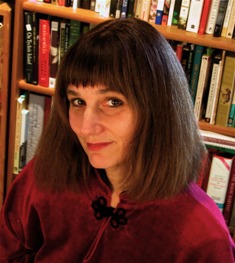
 Mira Bartók is a Chicago-born artist and writer and the author of twenty-eight books for children. Her writing has appeared in several literary journals and anthologies, and has been noted in The Best American Essays series. She lives in western Massachusetts, where she runs Mira List, a blog that helps artists find funding and residences all over the world. She has received awards from such organizations as the Fulbright-Hayes Foundation, the Associated Writing Programs, the Illinois Arts Council, Pollock-Krasner Grant, and the Carnegie Fund for Writers. Here she talks about the Christmas she spent in the Arctic while on a Fulbright Fellowship.
Mira Bartók is a Chicago-born artist and writer and the author of twenty-eight books for children. Her writing has appeared in several literary journals and anthologies, and has been noted in The Best American Essays series. She lives in western Massachusetts, where she runs Mira List, a blog that helps artists find funding and residences all over the world. She has received awards from such organizations as the Fulbright-Hayes Foundation, the Associated Writing Programs, the Illinois Arts Council, Pollock-Krasner Grant, and the Carnegie Fund for Writers. Here she talks about the Christmas she spent in the Arctic while on a Fulbright Fellowship.
December 1996 began with snow and mice, loneliness and hardship. I had been living for nine months in a two-room cabin in the middle of the woods in southern Norway with my first husband. We had wanted to live like Thoreau before we made the long flight up north to the Arctic, where I would begin my Fulbright research in Sámi (Lapp) folklore and anthropology. But unlike Thoreau, whose mother brought him sandwiches and washed his clothes, my husband and I were too far from civilization. I had a close friend in Oslo, an hour and a half away by bus, but my husband was determined to, as Thoreau suggested, “spend our days as deliberately as Nature.” So we washed all our clothes by hand, trudged two hours in deep snow to the nearest grocery store and hauled our water from a well a quarter of a mile away. And then, there were the mice --- an army of them. They scurried over our bodies at night, soiling everything in their path. The day I found that they had nested in my underwear drawer and bore offspring in the folds of my panties, I knew it was time to head north. I wanted to be rodent-free in a warm cozy home in time for the holidays, even if it was on the frozen tundra.
We arrived in Northern Norway on December 18th during the Dark Time, what the Sámi call Skalbma Dalvi, the Beautiful Darkness. There was no sun, only two hours of Arctic twilight a day. It was impossible tell what time it was. Sometimes we’d get up around noon and wander outside to look at the stars. Or we’d take a walk at three in the morning to peer into shop windows in town. I learned to tell it was night without looking at a clock by when our neighbor’s sled dogs began their nocturnal howling at the moon. It was both a melancholy and a magical place. Quiet, mystical and dangerously cold.
My husband and I were staying in a single dorm room at the Sámi College because we hadn’t yet found an apartment in town. Christmas was coming and we had wanted to be in our own place by then. But as the 25th grew closer, it was clear that we were going to have to spend our holiday in a dorm room by ourselves. I wasn’t the happiest camper in the world that Christmas/Chanukah season. My friends and family were far away, I hadn’t seen my mother in years, and my marriage was on the rocks.
Then, on Christmas Eve, there came a knock at the door. I opened it up to find two giggling elves, my new friend Ristiina’s daughters. They danced around the room, handed me a basket of candy and fruit then invited us over for Christmas Eve dinner later that evening.
When we arrived at Ristiina’s home, her family was already there. Ole Turi, Ristiina’s father, a large, imposing man of about seventy, sat stiffly at the head of the table in traditional Sámi regalia, with a tall red Sámi hat topped by five dark blue points that symbolize the stars. Everyone was talking and eating when Ole Turi cleared his throat. His voice was soft and low. He said, in Sámi, “The problem with kids today is they don’t know how to sleep in snow.”
Ristiina’s father began to hypnotize us with stories, told just above a whisper --- a tale about how he got caught in a blizzard once and had to dig a hole in the snow and sleep there until morning. Then another one about a perilous journey he took as a child to Baffin Island, across the Bering Straight, and another story about a strange and magical lake. Other family members began to talk, telling tales of the Uldat, the invisible people who live beneath the earth, and stories about Fox, the trickster, and Stallu, the stupid but terrible shape-shifting giant in Sámi folklore.
After dinner, we moved to the living room in front of the fireplace and ate chocolate cake with cloudberries topped with cream. The stories went on deep into the night. I know I told them stories too, but now, so many years later, I can’t remember what tales I told. But I remember that these were the precious gifts we exchanged with one another, that Arctic Christmas, sitting around the fire, as the wind howled outside the window, and the snow drifted against the door.
Read more about Mira Bartók on her website www.thememorypalace.com. You can also view her book trailer at http://www.youtube.com/watch?v=mE5j8NIrXRg


